EDITOR’S NOTE: This article is about how blockchain is helping the food industry to better serve consumers around the globe. True Interaction built SYNAPTIK, our Data Management, Analytics, and Data Science Simulation DMP, specifically to make it easy for leaders to collect and manage data, for instance from blockchain databases, to get to insights faster. For more information or a demo, please visit us at https://synaptik.co/ or email us at hello@www.true.design.
For now, Bitcoin is getting all the headlines. Yet the versatility of the blockchain will likely be the disruption to remember.
Initially constructed as a technology underlying Bitcoin, a cryptocurrency, the blockchain is a decentralized ledger that records transactions. What makes the blockchain a disruptive innovation is that the transactions are almost impossible to edit or manipulate after the fact because they are encrypted and provide alerts when any part of the chain is altered. The potential applications of the blockchain are still being discovered given the many ways that different industries conduct transactions.
The food industry is one area in which the blockchain already enjoys an immediate impact. Below are three ways in which the blockchain will improve operations across this critical industry:
Supply Chain: The blockchain is currently enhancing supply chain management across the food industry. Food industry giants such as Walmart, Kroger and Tyson Foods have begun automating their supply chains by tracking key information including the temperature, quality and shipping dates of certain perishable and non-perishable goods. Blockchain providers such as IBM are already looking to partner with similar enterprises so that these metrics are stored on an un-editable ledger to ensure fidelity of the supply chain from producer to consumer. This ledger will also be able to serve as a transparent database, allowing food industry companies to leverage analytics to better understand their supply chain bottlenecks, efficiencies and areas for transformation.
Food Safety: The blockchain used to monitor supply chain transactions also has the potential to dramatically improve food safety, a serious issue in much of the developing world. A late 2015 report from the World Health Organization (WHO) estimates that every year 1 in 10 people fall ill from eating contaminated foods. The effects of food safety challenges are particularly acute in the young, with over 125,000 children estimated to die annually from unsafe foods. Blockchain stands to reduce these unfortunate and preventble incidents in three ways: 1.) by providing consumers with transparency that the foods they are eating match the ingredients on the label; 2.) by capturing any event in which the food may be tampered with at any point in the supply chain, and 3.) by enabling retailers to pull potentially hazardous foodstuffs from shelves given any incident.
Payments: Blockchain stands to transform payments in the food industry. Food producers, many of whom sell their items at commodity rates, would be able to demonstrate proof of sale instantly using blockchain technology. Similarly, food distributors would be able to make payments to producers with greater ease and trust. Blockchain technology also has the potential to cut out middlemen and lower transaction fees, another promising development for small- or medium-sized food producers.
References
1.) https://theconversation.com/how-blockchain-technology-could-transform-the-food-industry-89348
2.) http://www.who.int/mediacentre/news/releases/2015/foodborne-disease-estimates/en/
3.) http://fortune.com/2017/08/22/walmart-blockchain-ibm-food-nestle-unilever-tyson-dole/
4.) https://www.anxintl.com/blog/2017/11/27/the-next-industry-to-be-revolutionised-by-blockchain-the-food-industry

